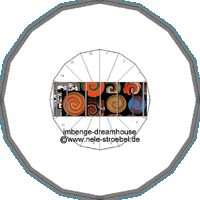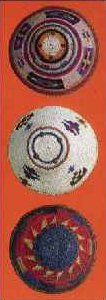© NELE STRÖBEL |
imbenge-dreamhouse |
 |
The 'imbenge-dreamhouse' -
| ||
 |
There weren't any pianos that had to be manhandled upstairs but the load was just as heavy, complex and fragile: twelve South African, German, French and Japanese men and women artists wanted to create a Gesamtkunstwerk [total work of art] as a communal project. The idea occurred to me while I was travelling through southern Africa. There I had acquired what are called imbenge , wickerwork woven of telephone wire in sometimes psychedelically arranged patterns of the kind Zulu artists have been making since the 1970s. Back home in Munich I heard that, since the telegraph office in the Munich Residenz was to be closed, a great many tonnes of this beautiful material would have to be thrown away. So the idea was born of using pieces of this historic wire to construct a house of communication, a space for the intercultural dialogue. This 'modern cabinet of marvels' was given the name 'imbenge-dreamhouse'. (Imbenge is the term used in southern Africa to denote a technique of weaving grass, by means of which the finely woven covers for (beer) vessels are made. Nowadays telephone cable is often used instead of grass.) |
|
The 'imbenge-dreamhouse' is a round structure consisting of twelve individual segments 1.20 metres wide and 2 metres high, which can be firmly interlocked. The frames are of aluminium moulding with a grid of holes drilled into the inner edges. To build it we needed working time together in a communal space. We worked at two different places: at the Staatliches Museum für Völkerkunde [State Museum of Ethnology] in Munich and the Documentary Centre in Durban. Enormous commitment was shown in developing, discussing, explaining, modifying and further processing the very different ideas on how to design the frames. We worked at once from the outside inwards to the centre of the house and inside it, for the most part individually, sometimes collectively, deep in conversation or silently. A space of intensive experience emerged. The activities of our neighbours became sources of inspiration, sparked off surprise and astonishment but could also simply be cut out. By living in the same room, structuring our time and working, we did not have to keep getting used to one another again and again. Everyone was simply there and contributed something. The many communal tea-times, suppers and evening activities were also arranged in the same way. Everyone was there as a matter of course and the rest took place spontaneously. To finish off the workshop, the twelve very different segments of the 'imbenge-dreamhouse' were reassembled. Let us begin in a clockwise direction: Alfred Fana Radebe made and designed the entrance with a net curtain; the upper middle is marked by an 'analogue CD' I produced in Munich. He was followed by Alfred Fana Radebe's two-piece play for women 'In Memory of the March to the Union Building in Pretoria in 1956'. Its frame consisted of two female figures, one inside, the other outside, as a tribute to communication between women across the world. In the next frame Pipon wove white telephone wire and crossed it with a horizontal bolt of red wire. Lamps are enmeshed in it to form a quiet, self-illuminating surface which can also be used for projection. Icons are mounted on the outside of Mandla Sibiloane's horizontally striped wall of yellow, green, red and white telephone wire, which deals with communicaton in rural and urban environments. Venske & Spänle installed a work in Munich entitled 'Der Knoten - Welcome to Verizon' ['The Knot - Welcome to Verizon'], which they describe as follows: 'A hopeless knot of cables, a chaos which can no longer be disentangled but from which a new cable must be drawn for each new connection.' If one lifts the telephone receiver chained to the cable connections, the tape drones: 'Welcome to Verizon. You will be disconnected' in an endless loop. Riaan Booysen set up a telephone call-box inside the 'imbenge-dreamhouse'. The receiver and the keypad are mounted on a South African flag made of telephone wire. The flag is stretched like a microchip in a frame of strands of yellow wire in cable channels. 'SIT IN / VERWEILE DOCH' ['LINGER'] is what my contribution on the walls is called, a telescoped version of the invitation to linger in Goethe's Faust and the Anglo-Saxon invitation to sit down and stay a while. An utterly commonplace African plastic chair, a discard from the Documentary Centre furnishings, was sawn into five equal parts. The individual segments were given a coating of black-and-white striped telephone wire. The patterns thus created, so reminiscent of Ikat, recall supermarket bar codes. The individual parts of the chair were tied into the frame with telephone wire tautened to form a rhythmic composition. Enoch Ngwenya designed the next frame in our virtual tour of the work. He used blue spirals to divide his symmetrical colour wall, vertically striped in blue, green, white, red and yellow. Six imbenge hemispheres and an illuminated mask made of telephone wire are attached to the inside of his frame. Chiharu Shiota came across a ready-made in a hardware store. A perfunctorily glued together wooden window, it has six panes puttied in to it. It is so makeshift that it looks like a fragile luxury accessory intended for a simple wooden shack. Its fragility is anchored and at once visually reinforced in the frame by a red nervous system of telephone wires. A small pill has been woven into the synapses, an ironical reminder of battling coughs and colds: the abrupt change of climate from wintery Germany to subtropical KwaZulu Natal was not without consequences for some of us who worked on the 'imbenge-dreamhouse'. Happiness Sdudla completed in Durban the frame which Chaifas had begun in Munich. She formed horizontal colour surfaces of grey, red, green, yellow and white telephone wires with the welcoming words in Zulu 'SAWUBONA' worked on them in wire. The second work by Venske & Spänle was also first realised in Durban. A digital print shows a distribution board for telephone connections in Brooklin and is the companion-piece to their 'Der Knoten - Welcome to Verizon' ['The Knot - Welcome to Verizon'] in the frame across from it. The tour ends at Zola Hector Sentini's pictorial relief with raised symbols for Europe and Africa. Table Mountain, a telephone, Big Five, football and the Eiffel Tower with a radio and television aerial have been formed from telephone wire and worked into the frame. In Africa, the house was roofed over with a digitally printed textile roof which told stories in pictures from the Munich phase. While touring European and African museums and galleries, the 'imbenge-dreamhouse' is to be given a new round roof after a design of mine, with African stories in pictures compiled on it. Mapping of this kind is to accompany the project continuously, symbolizing the processual character of the 'imbenge-dreamhouse'. The activities centred on the 'imbenge-dreamhouse' have been accompanied and documented by the Munich film-makers Stefanie Sycholt and German Kral. In addition, film material has been produced on the traditional way of making imbenge from grass. The setting for other pictures was the private Phansi Museum, owned by the architect Paul Mikula in Durban, one of the largest Zulu collections in South Africa, which has numerous clay vessels for storing beer with covers woven in the imbenge technique. A statement made by Zola demonstrates the importance the communal work assumed with time for all participants: 'Now we're connected. Let's build an "imbenge-dreamhouse" every year on a different continent!' |
|